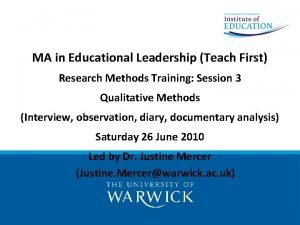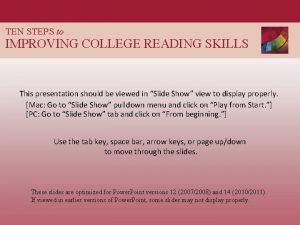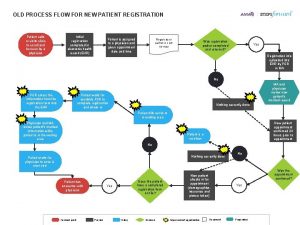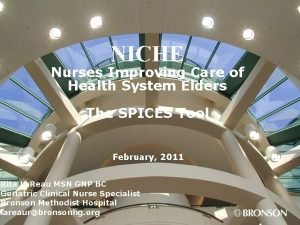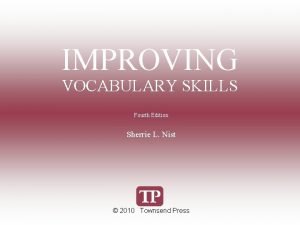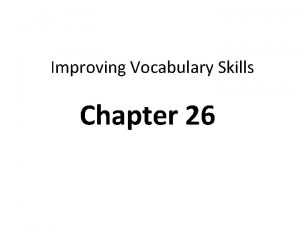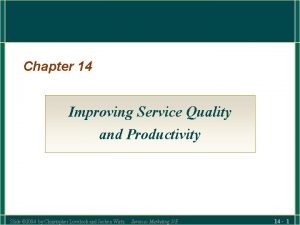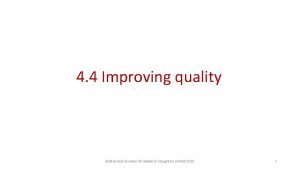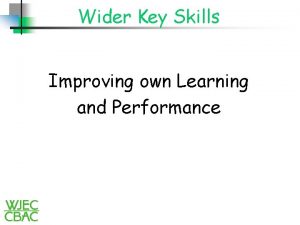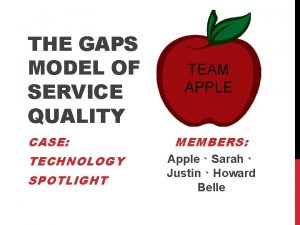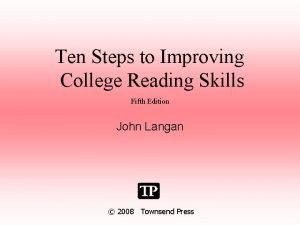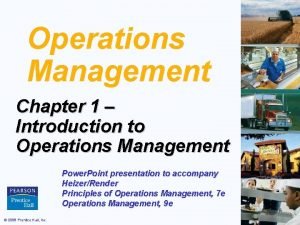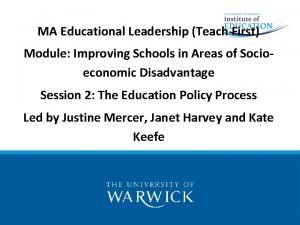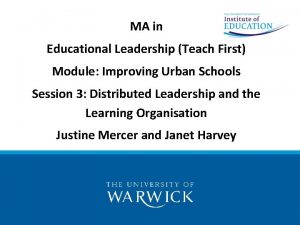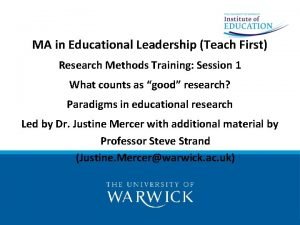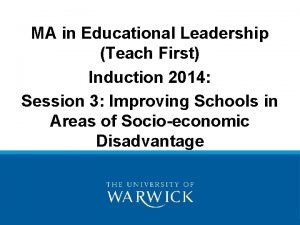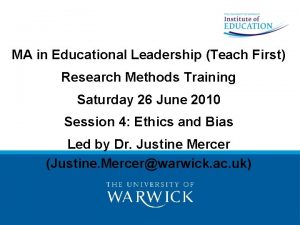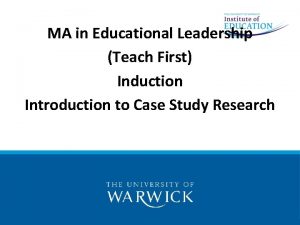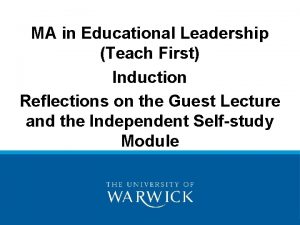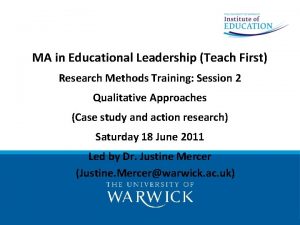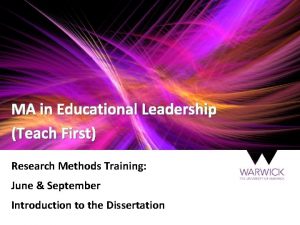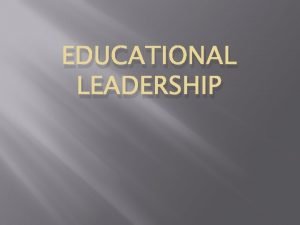MA in Educational Leadership Teach First Module Improving









![Both are necessary “Methods … [are] as important as knowledge, understanding and value orientations Both are necessary “Methods … [are] as important as knowledge, understanding and value orientations](https://slidetodoc.com/presentation_image/c7e97b73199734274fd25ded4c68ded0/image-10.jpg)












- Slides: 22

MA in Educational Leadership (Teach First) Module: Improving Urban Schools Session 2: Seven strong claims about successful school leadership Led by Justine Mercer and Janet Harvey

Activity 1: Feedback on Tony Bush’s Lecture In small groups, discuss your reactions to the guest lecture. Use the following questions as a guide: 1. Which parts of the talk resonated with your own experience? Try to be as specific as possible. 2. Which parts surprised you? 3. How far did the questions you wrote about the prereading get answered in the talk? 4. What more, if anything, would you still like to know about leadership for learning?

Activity 2: Leadership versus Management? 1) Make a list of words you associate with management 2) Make a list of words you associate with leadership 3) How much overlap is there between these two concepts? 4) Which is more important in a school context, leadership or management?

Leadership: üdoing the right things Management: üdoing things right

Leadership • Vision • Inspiration • Values and culture • Outward-looking • The Future • Strategic planning and decision-making • Examples from your experience? Management • Monitoring and controlling activities • Allocating resources • Inward-looking • Current organisation & implementation • Tactical planning and decision-making • Operational factors • Examples from your experience?

Bush (2003) Management Theories: Formal, Collegial, Political, Subjective, Ambiguity, Cultural Leadership Theories: Managerial, Participative, Transformational, Distributed, Transactional, Post-modern, Moral, Instructional, Contingency

Useful distinction “Leadership and management are not synonymous terms. One can be a leader without being a manager. One can, for example, fulfil many of the symbolic, inspirational, educational and normative functions of a leader and thus represent what an organisation stands for without carrying out any of the formal burdens of management. Conversely, one can manage without leading. An individual can monitor and control organisational activities, make decisions, and allocate resources, without fulfilling the symbolic, normative, inspirational, educational functions of leadership. ” (Schon 1984: 36)

Both are necessary “Organisations which are over managed but under led eventually lose all sense of spirit or purpose. Poorly managed organisations with strong charismatic leaders may soar temporarily only to crash shortly thereafter. The challenge of modern organisations requires the objective perspective of the manager as well as the brilliant flashes of vision and commitment wise leadership provides. ” (Bolman and Deal 1991: xiii-xiv)

Both are necessary “It is not enough for leaders to have the vision, sell it and then move on, leaving others to translate it into action. Implementation of the strategic plan needs continual monitoring and evaluation by those with the creative ability to understand where diversions may be appropriate and how obstacles can be surmounted. Strategic plans should, after all, be liberating, and not constraining. ” (Hall 1998: 145)
![Both are necessary Methods are as important as knowledge understanding and value orientations Both are necessary “Methods … [are] as important as knowledge, understanding and value orientations](https://slidetodoc.com/presentation_image/c7e97b73199734274fd25ded4c68ded0/image-10.jpg)
Both are necessary “Methods … [are] as important as knowledge, understanding and value orientations … Erecting this kind of dichotomy between something pure called ‘leadership’ and something dirty called ‘management’, or between values and purposes on the one hand methods and skills on the other, would be disastrous. ” (Glatter 1997: 189)

Fullan (1992: 19) “The current emphasis on vision in leadership can be misleading. Vision can blind leaders in a number of ways. . . The high-powered, charismatic principal who ‘radically transforms the school’ in four or five years can. . . be blinding and misleading as a role model. . . my hypothesis would be that most such schools decline after the leader leaves. . . Principals are blinded by their own vision when they feel they must manipulate the teachers and the school culture to conform to it. ”

Activity 3: Leaders Inside and Outside Education Think of someone you regard as a successful leader in an organisation outside the field of education: 1) List their personal characteristics and attributes 2) List their practices and behaviours 3) How and why do you think they became admirable leaders (journey to leadership)? Now do the same for someone who works in education To what extent are your answers different for the two people? How far, if at all, are educational leaders different to leaders in other fields?

Early Leadership Theories • Great Man Theories • Trait Theories • Situational Theories Examples? • Management Theories- focus on the role of supervision, organisation and group performance - transactional • Relationship Theories – focus on connections between leaders and followers - transformational but power imbalance remains • Participative Theories – encourages participation and contribution from others – interactive and distributed leadership

Transactional/Transformational Leadership • Transactional leadership – followers agree to work towards organisational goals and leaders agree to ensure good working conditions (associated with school effectiveness) Examples? • Transformational leadership – leaders and followers are united in pursuit of higher level goals (often associated with school improvement) Examples?

Transactional Leadership • Based on a “transaction” or simple “exchange” – like buying and selling a car. • Focus on task/outcome, not process • Followers agree to work toward organisational goals and leaders agree to ensure good working conditions. • Extrinsic motivation – “I’ll do what the boss tells me because I want to keep my job. ” And “My employees obey me because I pay their wages. ” • No shared values or long-term commitment. • In what circumstances might transactional leadership be effective?

Transformational Leadership (Leithwood and Jantzi, 2005) • Focus on process as well as outcome • Leader “transforms” their followers – they become different people, more skilful, more confident, perhaps more motivated/committed • Both leaders and followers are united in pursuit of higher level goals. • Still relies on “charisma” and “heroic individuals”. • May not be genuinely empowering. • In what circumstances might transformational leadership be effective?

An alternative view • Move from hierarchical to shared leadership • Leadership can come from anywhere in a school • Leadership must come from everywhere in a school • Shared and distributed leadership is necessary for improving schools

Activity 4: Leadership Practices (Leithwood et al. 2008: 31 -32) Four core educational leadership practices, namely: • Building vision and setting directions; • Understanding and developing people; • Redesigning the organisation; • Managing the teaching and learning programme.

• Think about the educational leader you described in the previous activity. To what extent do they do the four things listed above? • Now think about the head of your school. To what extent do they do the fours things listed above? • Finally think about your immediate boss (head of department, subject co-ordinator, head of year, or whatever). To what extent do they do the fours things listed above? • To what extent can these four practices be learnt? And if so, how?

Activity 5: Leadership Traits (Leithwood et al. 2008: 36) • Open-minded • Ready to learn from others • Flexible but with a system of core values • Persistent (in pursuit of high expectations) • Resilient • Optimistic • To what extent does the educational leader you chose have these traits? What about your head? What about your immediate boss?

Activity 6: Influences on Staff Motivation, Commitment and Working Conditions (Leithwood et al. 2008: 32 -34) To what extent have leaders at your school (from the head downwards) affected your motivation, commitment and working conditions? Now make a list of all the things that have helped your classroom performance improve. Divide your list into human and non-human factors. Of the people involved, how many had a leadership position within the school hierarchy and a degree of authority?

Activity 7: Critiquing the literature 1) What is the evidence-base underpinning the Leithwood et al. (2008) paper? 2) On a scale of 1 to 10 (with 1 being the least robust and 10 being the most), where would you place the findings of this paper and why? 3) Would you take issue with any of Leithwood et al. ’s conclusions, and if so, why?
 Analytical verbs
Analytical verbs Teach first documentary
Teach first documentary Npl certificate in educational leadership
Npl certificate in educational leadership C device module module 1
C device module module 1 Transformational leader and transactional leader
Transformational leader and transactional leader Situational leadership vs adaptive leadership
Situational leadership vs adaptive leadership Enthusiastic beginner disillusioned learner
Enthusiastic beginner disillusioned learner First educational conference 1947
First educational conference 1947 Ten steps to improving college reading skills answer key
Ten steps to improving college reading skills answer key Patient registration workflow
Patient registration workflow Bronson intranet
Bronson intranet Improving vocabulary skills 4th edition pdf
Improving vocabulary skills 4th edition pdf Is drivers a verb
Is drivers a verb Modern software technologies
Modern software technologies Chapter 12 lesson 4 fitness safety and avoiding injuries
Chapter 12 lesson 4 fitness safety and avoiding injuries Improving software economics set 1
Improving software economics set 1 Improving service quality and productivity ppt
Improving service quality and productivity ppt A linear-time heuristic for improving network partitions
A linear-time heuristic for improving network partitions Methods of improving quality business a level
Methods of improving quality business a level Improving own learning and performance examples
Improving own learning and performance examples The service performance gap
The service performance gap Ten steps to advancing college reading skills
Ten steps to advancing college reading skills Improving productivity at starbucks
Improving productivity at starbucks

